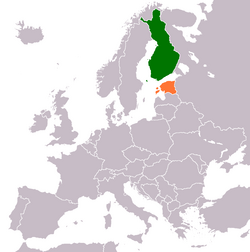Estonia–Finland relations
 | |
Finland |
Estonia |
|---|---|
Estonia–Finland relations are the bilateral relations between Finland and Estonia. The independent Republic of Finland, established in 1917, and the independent Republic of Estonia, established in 1918, established diplomatic relations and formally recognised each other in 1920. Diplomatic relations between the two countries were interrupted during World War II and officially restored on 29 August 1991. Finland has an embassy in Tallinn. Estonia has an embassy in Helsinki. Both countries are full members of the Council of the Baltic Sea States, Council of Europe, European Union, NATO and the Eurozone. Finland has given full support to Estonia's membership of the European Union. Estonia also has strongly supported Finland's NATO membership.[citation needed] The majority of languages in both countries are Finnic languages, as Finland's main language, Finnish, is related to Estonian, and there is and has been a certain feeling of kinship. 76% of Finns have visited Estonia, and in 2004, 1.8 million Finns reported visiting Estonia. The excise tax on alcohol is lower in Estonia than in Finland, thus it is common to buy large volumes of alcohol when returning from Estonia: a study in 2014 indicated that 34% of alcohol sold in Estonia is bought by Finns.[1] Finnish and Swedish investors are the largest foreign investors in Estonia.[2] Both Finland and Estonia are members of the European Union, Schengen agreement and the Eurozone, freeing international travel and trade between the countries. Finland is Estonia's top import partner, accounting for over 15% total import value in 2012, as well as the second-greatest market for Estonia's exports after Sweden. Finland's government recognised Estonia's independence in 1920. In response to the Soviet invasion, diplomatic missions were de facto removed. However, when Estonia restored its independence, this "temporary obstruction" was resolved. During the restoration of Estonia's independence, Finland secretly contributed with significant economic aid and know-how under the cover of "cultural co-operation" in order to not upset the Soviet Union.[3] Finland continues to contribute militarily, such as officers' training, and the provision of equipment.



History
[edit]This section needs expansion. You can help by adding to it. (November 2023) |

Unification proposals
[edit]In Finland, the idea of a unified Greater Finland gained popularity and influence rapidly in 1917, but lost support after World War II and the Continuation War.
In 1917, 1918 and 1940, the Estonian president Konstantin Päts wished for a union of Finnic countries in his political testament, writing an outline of a unification plan. He used the term "soomesugu" in Estonian to point to the people and countries of Finland and Estonia when talking about common border law.[4][5]
Anthem
[edit]The Finnish anthem Maamme and the similarly themed Estonian anthem Mu isamaa, mu õnn ja rõõm (My Fatherland, My Happiness and Joy, 1869) share the same melody.
This song is also considered to be the ethnic anthem of Livonians, titled Min izāmō, min sindimō (My Fatherland, My Native Land).
Regional cooperation
[edit]Both Finland and Estonia are members of the World Congress of Finno-Ugric Peoples
Finnish and Swedish investors are the largest foreign investors in Estonia.[2] Both Finland and Estonia are members of the European Union, Schengen Agreement and the Eurozone. Finland is Estonia's fourth greatest import partner, accounting for 8.48% of its imports between 2017 and 2021, as well as the greatest market for Estonia's exports, accounting for 12.2% of Estonia's exports.[6]
In July 2022, Estonia fully approved Finland's application for NATO membership.
Finland contributed and continues to contribute military aid to Estonia, such as officers' training, and the provision of equipment.[citation needed]
The Rail Baltica and Via Baltica, modern rail and road links of vital importance, connecting Finland with Estonia and Central Europe, remain under construction (as of 2022).
Balticconnector is a bi-directional natural gas pipeline between Finland and Estonia.
Resident diplomatic missions
[edit]-
Embassy of Estonia in Helsinki
-
Embassy of Finland in Tallinn
See also
[edit]- Foreign relations of Estonia
- Foreign relations of Finland
- Finnish–Estonian defence cooperation
- Finnish Infantry Regiment 200
- Estonians in Finland
- Estonian–Finnish federation
- Tuglas Society
References
[edit]- ^ "Third of Estonia's Alcohol Sales Attributed to Finnish Tourists". News.err.ee. 22 April 2014.
- ^ a b "Poliittiset suhteet - Suomen suurlähetystö, Tallinna". 10 June 2007. Archived from the original on 10 June 2007. Retrieved 11 January 2018.
- ^ "Ex-President Koivisto secretly funnelled money to support Estonian independence". YLE. 15 May 2017. Retrieved 31 August 2022.
Rausmaa's studies show that Finland contributed over 100 million Finnish marks towards Estonian independence by the year 1991. In addition to this material support, Finland provided expert consultation and training to its southern neighbour, which basically had to build a market economy and the system of democratic rule from scratch.
- ^ "Archived copy" (PDF). Archived from the original (PDF) on 2016-12-22. Retrieved 2017-01-05.
{{cite web}}: CS1 maint: archived copy as title (link) - ^ "Kuidas Konstantin Päts Eesti-Soome liitriiki soovis". Ohtuleht.ee. Retrieved 11 January 2018.
- ^ "Estonia Trade | WITS Data". wits.worldbank.org. Retrieved 2024-01-05.



